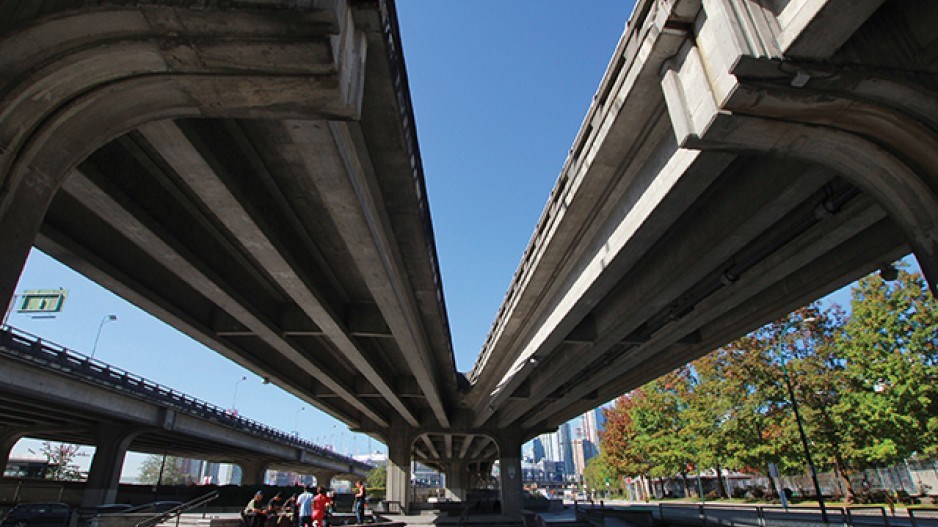While they aren’t designated heritage monuments by the City of Vancouver, the Georgia and Dunsmuir viaducts, twin bridges that span 2.6 kilometres and weigh 67,800 tonnes, are historic city structures.
Relics of a past vision of the municipality, they were the only substantial infrastructure projects, along with the Granville Street Bridge, to be completed during the city’s civic revolt of the late 1960s and early 1970s when protesters fought plans to drive a major freeway through downtown.
Now the two massive concrete structures, built from 26,500 cubic metres of concrete – the equivalent of 10 Olympic-sized swimming pools – are coming down, making way for a drastically new vision of northeast False Creek that will take decades and hundreds of millions of dollars to achieve. Right now daily volumes on the viaducts range from about 14,000 vehicles crossing the Dunsmuir structure to 21,000 on Georgia, numbers that have been decreasing since 1996.
Patrick Condon, a professor of urban design at the University of British Columbia’s School of Architecture and Landscape Architecture, noted the viaducts are owned by the city and not the province, which makes repairs more costly. Structures of their kind have a typical lifespan of about 40 to 60 years, which means the latest version of the viaducts, which were completed in 1972, are at the end of their structural lifespan, he said, adding that they are not up to current seismic standards and have other technical issues due to their age.
Demolishing them will carry a weighty price tag, he said.
“It’s quite expensive because you have to do it carefully. You have to take the pieces apart almost manually, and then there are removal costs and dumping costs. There are a lot of costs that people don’t imagine. Just removal and dumping costs can be a significant percentage, and that’s after you’ve torn the bloody thing down. It’s a really massive structure.”
According to a city report issued in January, the cost of removing both viaducts could top $200 million.
The city’s vision for the area after removal of the viaducts is ambitious. The redeveloped northeast False Creek, which will take decades to complete, will house upwards of 12,000 new residents and include 1,800 new social housing units and 32 acres of renewed and new park space. The city also estimates an economic benefit to the public of $1.7 billion when development is completed, factoring in 8,000 new jobs. Devan Fitch, manager of project delivery for engineering services at the City of Vancouver, said the “big, dramatic change” to northeast False Creek represents about $360 million worth of investment to take the viaducts down and build a new community. This will eventually encompass a streetcar network, Fitch said, but the immediate issue is revamping the area to modern traffic patterns and building a sustainable transit grid.
“There’s a big challenge to get a resilient network in place,” he said. “There’s a legacy of poor connectivity when it was a railroads and industry site. The rest of the network [was] bypassed … as the viaducts went overtop, so as we try and restitch this network back together that’s certainly a challenge we need to deal with.”
Fitch said the city has had high-level talks with some of the main tenants of the area, most notably Rogers Arena, BC Place and Costco.
The city’s report also noted the viaducts will be replaced with a new Pacific Boulevard and Georgia Street and that studies have shown the new street network will be able to handle “100% of the current and future traffic volume and will be better adapted to accommodating improved options for moving around the area.”
Brian Higgins, a real estate agent with Prompton Real Estate Services Inc. in the Marinaside area, who previously lived next to the viaducts, said he’s pleased with the plan for the area as envisioned by the city and by landowner Concord Pacific. The municipality didn’t “sell its soul” with the mixed-use development plan, he said, as there is a wide variety of amenities in it, including social housing, restaurants, commercial space and parkland.
Keith Sashaw, president of the Association of Consulting Engineering Companies of British Columbia, said he thinks removing the viaducts is a good idea, noting the decline in traffic on the structures.
“What we see in Vancouver is that we’re actually seeing fewer people drive into the downtown core, and that’s steadily declining and that’s improving transit and cycling. And this is with more people living in the downtown core, so I think it’s a very good move.”




